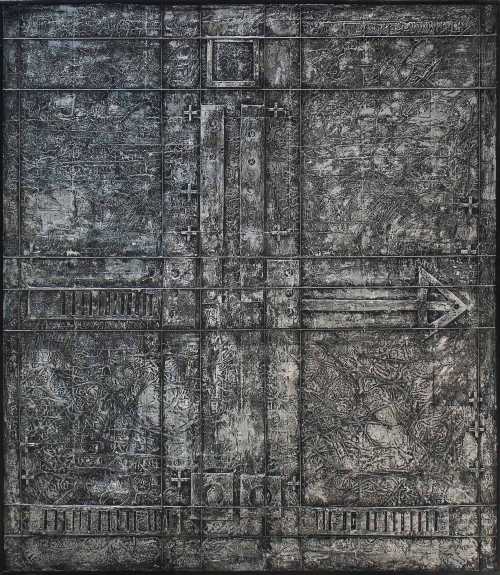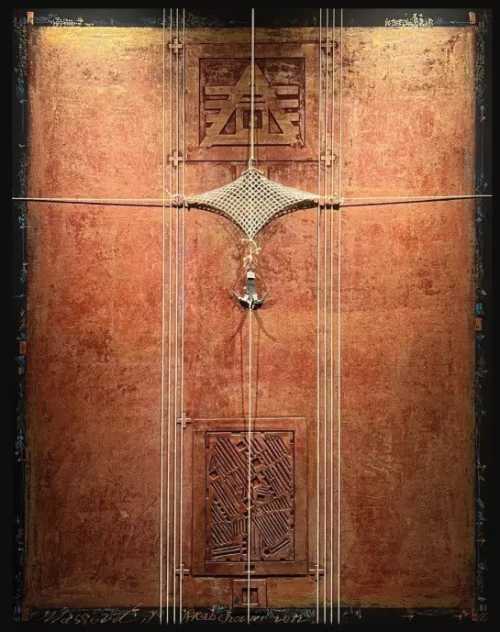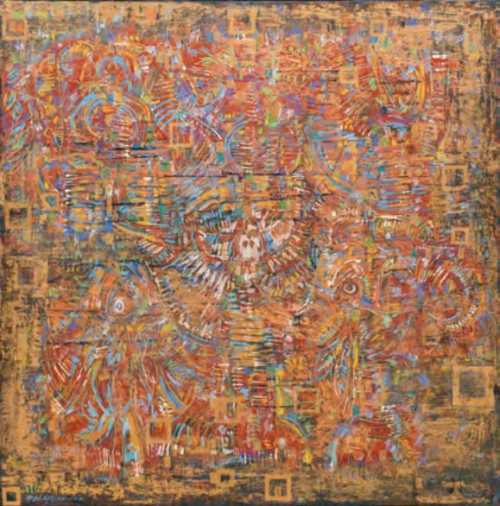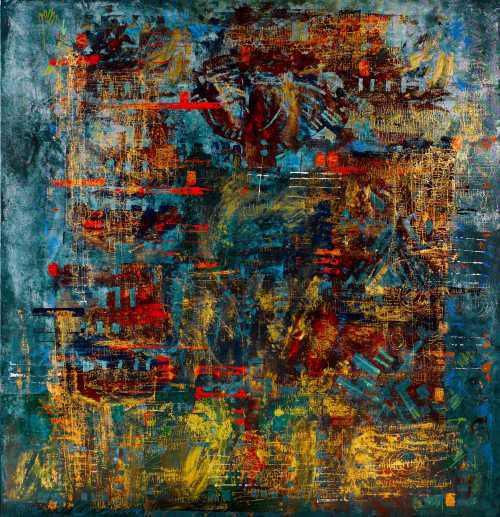- Beyond the Lines 1978
- Oil and aluminum on canvas
- Painting
- 200 * 230 cm
- signed and dated in Farsi (lower right)
Artwork Description
The Iranian artist Massoud Arabshahi is celebrated for his unprecedented use of symbolism in abstract art. The present work subtly combines symbols of past and present. Arabshahi's monumental composition questions language as the sole means of expression; many symbols he uses, including the lotus, the wheel, the shining sun, and the tree of life are juxtaposed with geometrical symbols such as circles, squares, curves, and spirals.
These shapes carry great meaning in Arabshahi's oeuvre. The circle is the symbol of the universe in its whole and original perfection. In Islamic art, it represents the vaulted sky and divine light. The square evokes perfect stability. A square inside a circle or a circle inside a square represents a transformation of the spherical form of the sky on a rectangular Earth or vice versa. In Islam, these symbols often signify the union of all states of being, sublime identity, and horizontal and vertical expansion. The vertical line is the embodiment of celestial, spiritual, subjective, positive and active feature, whereas the horizontal line demonstrates earthly, logical, passive, and negative aspects.
Massoud Arabshahi combines his search for meaning and direction in today's art world with his continuous urge to question the beliefs and symbols of ancient Persia's iconology and visual vocabulary. His work is unique and rare, as are his ideas and outtake on what the Middle East historically encompasses. The present work, a magnificent and timeless composition, is one of Arabshahi's most striking works.
Just as the present is a confluence of the past and future, Massoud Arabshahi's work is a juxtaposition of the ancient and the futuristic. For over thirty years his work has encompassed large-scale sculpture, relief architecture and murals, in a wide array of techniques. His creativity and perception maintain the simple geometric shapes of antiquity, infusing them with elaborate delineation and texturing, conveying a sense of the finite and producing an aesthetically balanced whole.
Geometric shapes carry meaning in Arabshahi's oeuvre. The circle is the symbol of the universe, wholeness, and original perfection. In Islamic art the circle represents the vaulted sky and divine light; the square manifests the earth and perfect stability. A square inside a circle or a circle inside a square represents a transformation of the spherical form of the sky on a rectangular Earth or vice versa. In Mandela, circle mainly delineates the whole nature and square shapes indicate recognition of this wholeness in the consciousness. The cross has been a universal symbol ever since antiquity. It manifests the center of the world; a point where the earth and heaven meet; a cosmic axis. The cross also represents an archetype of man capable of expanding infinitely and harmoniously in both horizontal and vertical planes. In Islam it signifies the union of all states of being, sublime identity and horizontal and vertical expansion. The vertical line is the celestial, spiritual, subjective, positive and active aspects, whereas the horizontal line demonstrates earthly, logical, passive and negative aspects. The spiral has long been utilized in arts: solar and lunar powers, universal revolution, the Sun's orbit, seasons, and rotation of the Earth and creative powers. Double spirals represented rhythms of nature.
Application of these elements attaches a geometric sense to Arabshahi's works, and also brings his art closer to modernism. This is particularly true when his latest conception of space (from the point of view of modern architecture or cosmic dimension) is brought to light. At this stage, the elements of the third group gather force and significance. We might have seen arrows, scales, numbers, parabolic lines, hatching and graffiti in the artistic creations of many 20th-century artists. Their presence in Arabshahi's paintings, however, denotes a different concept, which is to beckon the mysterious spirit of ancient times into the dynamic world of today.
These shapes carry great meaning in Arabshahi's oeuvre. The circle is the symbol of the universe in its whole and original perfection. In Islamic art, it represents the vaulted sky and divine light. The square evokes perfect stability. A square inside a circle or a circle inside a square represents a transformation of the spherical form of the sky on a rectangular Earth or vice versa. In Islam, these symbols often signify the union of all states of being, sublime identity, and horizontal and vertical expansion. The vertical line is the embodiment of celestial, spiritual, subjective, positive and active feature, whereas the horizontal line demonstrates earthly, logical, passive, and negative aspects.
Massoud Arabshahi combines his search for meaning and direction in today's art world with his continuous urge to question the beliefs and symbols of ancient Persia's iconology and visual vocabulary. His work is unique and rare, as are his ideas and outtake on what the Middle East historically encompasses. The present work, a magnificent and timeless composition, is one of Arabshahi's most striking works.
Just as the present is a confluence of the past and future, Massoud Arabshahi's work is a juxtaposition of the ancient and the futuristic. For over thirty years his work has encompassed large-scale sculpture, relief architecture and murals, in a wide array of techniques. His creativity and perception maintain the simple geometric shapes of antiquity, infusing them with elaborate delineation and texturing, conveying a sense of the finite and producing an aesthetically balanced whole.
Geometric shapes carry meaning in Arabshahi's oeuvre. The circle is the symbol of the universe, wholeness, and original perfection. In Islamic art the circle represents the vaulted sky and divine light; the square manifests the earth and perfect stability. A square inside a circle or a circle inside a square represents a transformation of the spherical form of the sky on a rectangular Earth or vice versa. In Mandela, circle mainly delineates the whole nature and square shapes indicate recognition of this wholeness in the consciousness. The cross has been a universal symbol ever since antiquity. It manifests the center of the world; a point where the earth and heaven meet; a cosmic axis. The cross also represents an archetype of man capable of expanding infinitely and harmoniously in both horizontal and vertical planes. In Islam it signifies the union of all states of being, sublime identity and horizontal and vertical expansion. The vertical line is the celestial, spiritual, subjective, positive and active aspects, whereas the horizontal line demonstrates earthly, logical, passive and negative aspects. The spiral has long been utilized in arts: solar and lunar powers, universal revolution, the Sun's orbit, seasons, and rotation of the Earth and creative powers. Double spirals represented rhythms of nature.
Application of these elements attaches a geometric sense to Arabshahi's works, and also brings his art closer to modernism. This is particularly true when his latest conception of space (from the point of view of modern architecture or cosmic dimension) is brought to light. At this stage, the elements of the third group gather force and significance. We might have seen arrows, scales, numbers, parabolic lines, hatching and graffiti in the artistic creations of many 20th-century artists. Their presence in Arabshahi's paintings, however, denotes a different concept, which is to beckon the mysterious spirit of ancient times into the dynamic world of today.
Realized Price
38,880 USD
Min Estimate
25,931 USD
Max Estimate
34,968 USD
Average Artwork Worth
+26.468%
Average Growth of Artwork Worth
Sales Performance Against Estimates
Average & Median Sold Lot Value
2021 - 2025
Performance vs. Estimate
2021 - 2025
Sell-through Rate
2021 - 2025
Similar Artworks
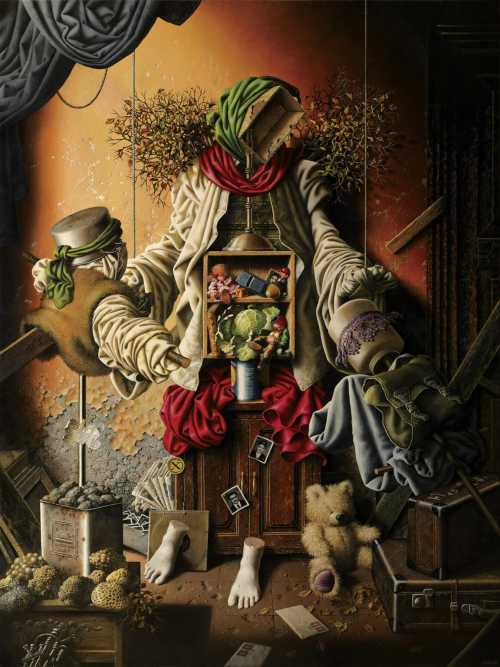
Forgiveness
Estimation
60,000,000,000﷼
70,588 USD
-
70,000,000,000﷼
82,353 USD
Realized Price
103,400,000,000﷼
121,647 USD
59.077%
Sale Date
Tehran
-
14 February 2025

Too Young to Go Steady
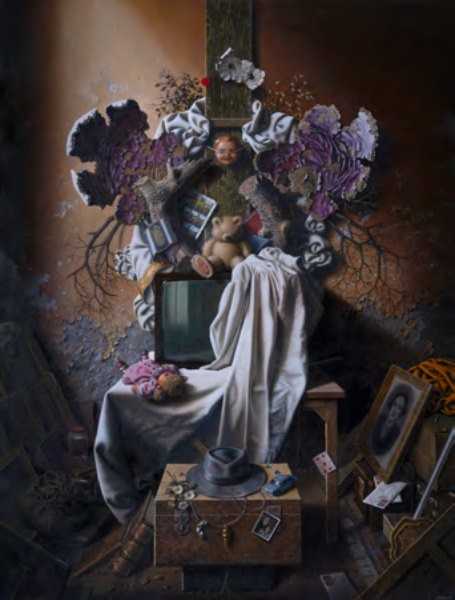
The Eighth Day of the Creation
Estimation
30,000,000,000﷼
60,000 USD
-
40,000,000,000﷼
80,000 USD
Realized Price
46,000,000,000﷼
92,000 USD
31.429%
Sale Date
Tehran
-
18 July 2023
